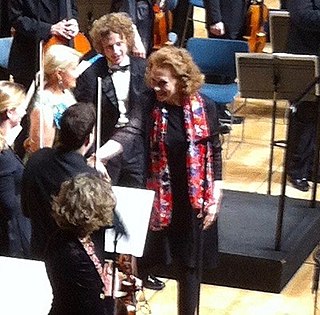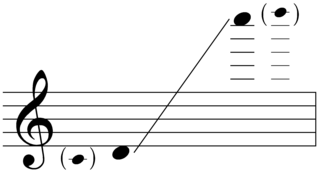Naïve and Sentimental Music is a symphonic work by the American composer John Adams. The title of the work alludes to an essay by Friedrich Schiller, On Naïve and Sentimental Poetry, that contrasts a creative personality that creates art for its own sake versus one conscious of other purposes, such as art’s place in history. The composer cites both the slowly developing harmonies of Bruckner's Fourth Symphony and the atmosphere of the Sonoma coastline as inspirations for the work. The piece was co-commissioned by the Los Angeles Philharmonic, the Ensemble Modern, the Vancouver Symphony Orchestra, and the Sydney Symphony Orchestra. It received its first public performance by the Los Angeles Philharmonic conducted by Esa-Pekka Salonen on February 19, 1999. A recording by Salonen and the Los Angeles Philharmonic was subsequently released by Nonesuch Records.
My Father Knew Charles Ives is an orchestral triptych by the American composer John Adams. The work was commissioned by the San Francisco Symphony. It was first performed by the San Francisco Symphony under the direction of Michael Tilson Thomas at the Louise M. Davies Symphony Hall on April 30, 2003.
Symphony No. 3 is an orchestral composition in two movements by the American composer Christopher Rouse. The work was jointly commissioned by the St. Louis Symphony, the Baltimore Symphony Orchestra, the Royal Stockholm Philharmonic Orchestra, and the Singapore Symphony Orchestra. It was completed February 3, 2011 and premiered May 5, 2011 by the Saint Louis Symphony under David Robertson at Powell Hall in St. Louis, Missouri. The piece is dedicated to Rouse's high school music teacher, John Merrill.
The Concerto for Orchestra is an orchestral composition by the American composer Christopher Rouse. The work was commissioned by the Cabrillo Festival of Contemporary Music and is dedicated to conductor and frequent Rouse collaborator Marin Alsop. The piece was completed February 24, 2008 and premiered at the festival August 1, 2008, with Marin Alsop leading the Cabrillo Festival Orchestra.
Radical Light is a single-movement orchestral composition by the American composer Steven Stucky. The work was commissioned by the Los Angeles Philharmonic with contributions from Lenore and Bernard Greenberg. It was premiered October 18, 2007 at the Walt Disney Concert Hall in Los Angeles, with conductor Esa-Pekka Salonen leading the Los Angeles Philharmonic. The title of the piece comes from the poem "He Held Radical Light" by A. R. Ammons.
The B-Sides is a symphony in five movements for electronica and orchestra by the American composer Mason Bates. The work was commissioned by the San Francisco Symphony and conductor Michael Tilson Thomas, with support from the Ralph I. Dorfman Commissioning Fund. It was premiered May 20, 2009 at the Louise M. Davies Symphony Hall in San Francisco, with Michael Tilson Thomas leading the San Francisco Symphony.
Anthology of Fantastic Zoology is an orchestral symphony by the American composer Mason Bates. The work was commissioned by the Chicago Symphony Orchestra, for whom Bates was then composer-in-residence. It was premiered June 18, 2015 at Symphony Center in Chicago, with the Chicago Symphony Orchestra performing under conductor Riccardo Muti, to whom the work is dedicated. The piece is based on the eponymous book by Jorge Luis Borges.
Nyx is a symphonic poem by the Finnish composer Esa-Pekka Salonen. The work was jointly commissioned by Radio France, the Barbican Centre, the Atlanta Symphony Orchestra, Carnegie Hall, and the Finnish Broadcasting Company. It was premiered February 19, 2011 in the Théâtre du Châtelet, Paris, with Salonen conducting the Orchestre Philharmonique de Radio France. The piece is titled after the Goddess Nyx from Greek mythology.
Fanfare Ritmico is a single-movement orchestral composition by the American composer Jennifer Higdon. The work was commissioned by The Women's Philharmonic as part of The Fanfares Project. It was given its world premiere in March 2000 by conductor Apo Hsu and the Women's Philharmonic.
The Cello Concerto is a concerto for solo cello and orchestra by the American composer Nico Muhly. The work was commissioned by the Barbican Centre for the Britten Sinfonia and cellist Oliver Coates, to whom Muhly dedicated the piece. It was first performed on March 16, 2012 at the Barbican Centre by Coates and the Britten Sinfonia under conductor André de Ridder.
The Stars and the Roses is a three-movement composition for tenor solo and orchestra set to the poetry of Czesław Miłosz by the American composer Steven Stucky. The work was commissioned by the Berkeley Symphony, for which Stucky was then composer-in-residence. It was first performed on March 28, 2013 by the tenor Noah Stewart and the Berkeley Symphony under the conductor Joana Carneiro. The work was rewritten by Stucky in a chamber arrangement of the piece that premiered on October 18, 2013 by the Curtis 20/21 Contemporary Music Ensemble and tenor Roy Hage. The piece is dedicated to Stucky's wife Kristen.
True Fire is a song cycle for solo baritone and orchestra by the Finnish composer Kaija Saariaho. The work was jointly commissioned by the Los Angeles Philharmonic, the NDR Symphony Orchestra, the BBC Symphony Orchestra and the Orchestre National de France. It was first performed at the Walt Disney Concert Hall in Los Angeles on May 14, 2015, by the baritone Gerald Finley and Los Angeles Philharmonic under the conductor Gustavo Dudamel. The piece is dedicated to Gerald Finley.
Maan varjot is a composition for solo organ and orchestra by the Finnish composer Kaija Saariaho. The work was jointly commissioned by the Montreal Symphony Orchestra, the Orchestre national de Lyon, Southbank Centre, and the Philharmonia Orchestra. It was first performed in Montreal on May 29, 2014, by the organist Olivier Latry and the Montreal Symphony Orchestra under the conductor Kent Nagano.
Circle Map is a composition for orchestra and electronics by the Finnish composer Kaija Saariaho. The work was jointly commissioned by the Royal Concertgebouw Orchestra, the Boston Symphony Orchestra, the Gothenburg Symphony Orchestra, the Orchestre National de France, the Royal Scottish National Orchestra, and the Stavanger Symphony Orchestra. It was first performed at the Holland Festival in Gashouder, Amsterdam on June 22, 2012, by the Royal Concertgebouw Orchestra under the conductor Susanna Mälkki.
Notes on Light is a cello concerto by the Finnish composer Kaija Saariaho. The work was commissioned by the Boston Symphony Orchestra and was first performed at Symphony Hall, Boston on February 22, 2007, by the cellist Anssi Karttunen and the Boston Symphony Orchestra under the conductor Jukka-Pekka Saraste.
The Piano Concerto No. 2 is a composition for solo piano and orchestra by the Finnish composer Magnus Lindberg. The work was jointly commissioned by the Royal Concertgebouw Orchestra, the Gothenburg Symphony Orchestra, and the New York Philharmonic, for which Lindberg was then composer-in-residence. It was given its world premiere at Avery Fisher Hall on May 3, 2012 by the pianist Yefim Bronfman and the New York Philharmonic under the direction of Alan Gilbert.
Polaris: Voyage for Orchestra is an orchestral composition by the British composer Thomas Adès. The work was co-commissioned by the New World Symphony under the direction of Michael Tilson Thomas for the opening of the New World Center. The New World Symphony was joined in commission by the Royal Concertgebouw Orchestra, the New York Philharmonic, the Calouste Gulbenkian Foundation, the Barbican Centre, the Los Angeles Philharmonic, and the San Francisco Symphony. It was given its world premiere by Michael Tilson Thomas and the New World Symphony at the New World Center in Miami Beach on January 26, 2011.
Auditorium is a 2016 composition for electronica and orchestra by the American composer Mason Bates. The work was commissioned by the San Francisco Symphony with support from Larry and Michèle Corash. Its world premiere was given by the San Francisco Symphony conducted by Pablo Heras-Casado on April 27, 2016. The piece is dedicated to Larry and Michèle Corash.












